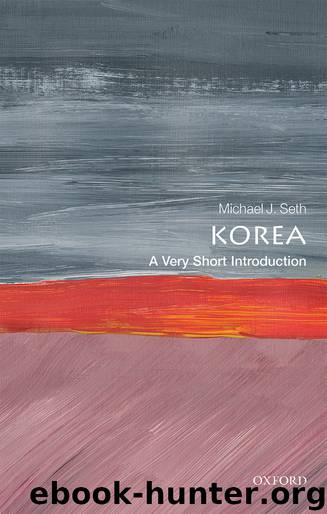Korea by Michael J. Seth

Author:Michael J. Seth
Language: eng
Format: epub
ISBN: 9780192566522
Publisher: OUP Oxford
Published: 2019-11-28T16:00:00+00:00
Wartime totalitarianism
Korea’s colonial experience took an increasingly authoritative and coercive turn in the 1930s. As the Great Depression engulfed much of the world, and the international trading system was replaced by a rise in protectionist policies, the Japanese government in Tokyo shifted in an increasingly militaristic, ultra-nationalist direction. In 1931, the Japanese began a takeover of Manchuria, creating a puppet state in the huge, resource-rich region. Six years later the Japanese launched a large-scale invasion of China, capturing its capital Nanjing in 1938. After the start of the war with China in 1937, Japan moved in an increasingly totalitarian direction at home and in Korea.
As the Japanese government moved in a more ultra-nationalist, expansionary direction it began insisting that Koreans actively support the goals of the empire. From 1935 all Koreans were required to worship at Shinto shrines. From 1937 they were required to recite the Oath of Subjects of the Imperial Nation. Schoolchildren began their day by bowing in the direction of the Imperial Palace in Tokyo. The colonial government closed Korean organizations, replacing them with large-scale state-sponsored ones. Writers belonged to the writers’ association designed to direct their efforts toward wartime propaganda, young people to the Korean Federation of Youth Organizations. In 1940, the entire country was organized into 350,000 Neighbourhood Patriotic Organizations, each with ten households. These new organizations were used by the state to collect contributions, carry out rationing, and organize people for ‘volunteer’ labour. Through them almost everyone was enlisted for tasks such as building airstrips and collecting useful materials for war production.
By 1940, the colony was taking on the character of a totalitarian state where all activity was directed towards the goals of the state. When the war expanded in late 1941 from a conflict with China to one with the United States and the British Empire, hundreds of thousands of Koreans were conscripted to work in Japan. School terms were shortened so that students could do voluntary labour and many young people were among those sent to Japan as labourers. In fact, by 1945 a sizeable portion of the total labour force in Japan was Korean (Figure 6). A most tragic development that remains a sore point between Korea and Japan today was the use of up to 200,000 young Korean women as ‘Comfort Women’. Recruited under false pretences they were forced to serve as prostitutes for Japanese troops. Returning home in disgrace, many had to carry the shame for their entire lives.
6. Recruitment of Korean workers for Japan, Kyǒngsang Province, c.1940.
Download
This site does not store any files on its server. We only index and link to content provided by other sites. Please contact the content providers to delete copyright contents if any and email us, we'll remove relevant links or contents immediately.
| Africa | Americas |
| Arctic & Antarctica | Asia |
| Australia & Oceania | Europe |
| Middle East | Russia |
| United States | World |
| Ancient Civilizations | Military |
| Historical Study & Educational Resources |
The Rape of Nanking by Iris Chang(3525)
The Sympathizer by Viet Thanh Nguyen(3506)
World without end by Ken Follett(3010)
Ants Among Elephants by Sujatha Gidla(2928)
Blood and Sand by Alex Von Tunzelmann(2611)
Japanese Design by Patricia J. Graham(2560)
City of Djinns: a year in Delhi by William Dalrymple(2138)
Inglorious Empire by Shashi Tharoor(2103)
In Order to Live: A North Korean Girl's Journey to Freedom by Yeonmi Park(2061)
Foreign Devils on the Silk Road: The Search for the Lost Treasures of Central Asia by Peter Hopkirk(2058)
Tokyo by Rob Goss(2022)
India's biggest cover-up by Dhar Anuj(1988)
India's Ancient Past by R.S. Sharma(1988)
The Great Game: On Secret Service in High Asia by Peter Hopkirk(1962)
Tokyo Geek's Guide: Manga, Anime, Gaming, Cosplay, Toys, Idols & More - The Ultimate Guide to Japan's Otaku Culture by Simone Gianni(1949)
Goodbye Madame Butterfly(1938)
The Queen of Nothing by Holly Black(1758)
Living Silence in Burma by Christina Fink(1732)
Batik by Rudolf Smend(1723)
